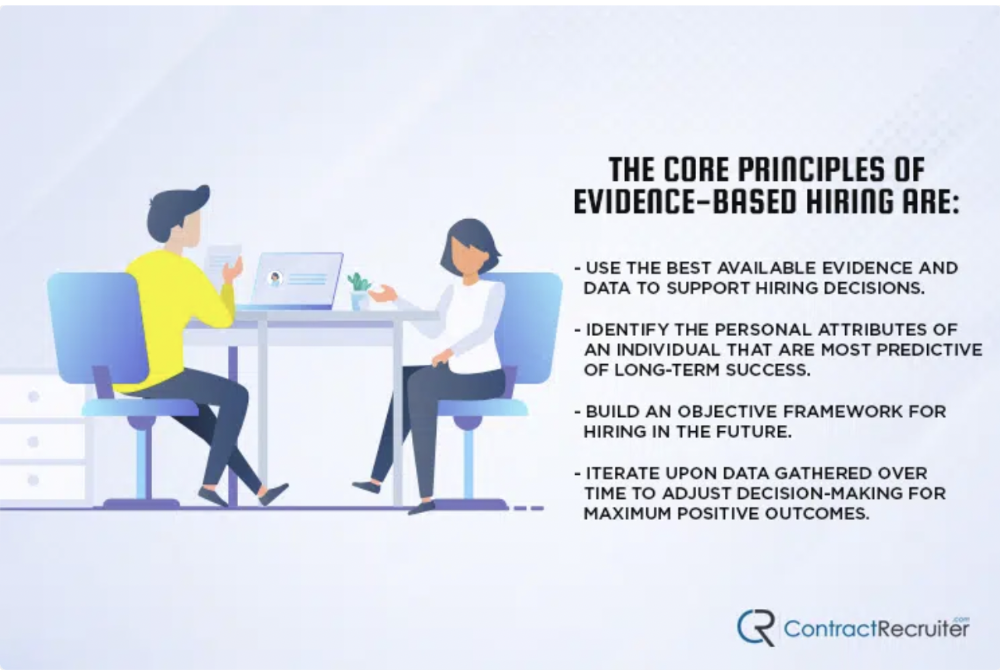What Is Evidence-Based Hiring and Why Is It Important?
You might think all hiring is based on evidence: information from resumes, gut feelings from interviews, and performance on skill tests. There’s “good” and “bad” evidence regarding hiring, and effective evidence-based hiring relies on the former.
In the context of effective evidence-based hiring, good evidence refers to the factors most predictive of job outcomes–based on data and science.
According to popular HR software, Criteria, evidence-based hiring is “based on the evidence compiled from extensive research in organizational psychology. This evidence is used to determine scientifically which factors are more likely to predict job performance than others. Organizations can improve their hiring outcomes by building a hiring process incorporating more predictive factors and weighing them more heavily.”
In the current labor climate—where turnover (and its costs) remains high, quality candidates are few and far between, and hybrid work makes detecting threats more difficult—more and more companies are turning to evidence-based hiring to attract quality employees and prevent bad hires.
Evidence-Based Hiring Is a Two-Way Street
Evidence-based hiring is about streamlining the hiring process for both candidates and companies. Many organizations–scared of making bad hires–have designed bloated, bureaucratic hiring processes rife with bias and impressionistic assessments. Their intentions are good: to make the best possible hire for their business. But, the outcome is not what they seek.
Quality, modern-day employees won’t tolerate drawn-out, overly complicated hiring anymore. That process doesn’t account for the metrics that determine employee productivity and retention. Plus, it leaves room for prejudice and discrimination in a world where many companies want to diversify their workforce.
As a result, organizations are being pushed to bring more fairness and data-driven insights to the hiring process. They’re adapting to the modern labor landscape by creating hiring frameworks based on data and research rather than impressions. They’re using numerical ratings for interviews rather than qualitative assessments to predict quality candidates in the future. They monitor problematic interviewer feedback to screen for bias, malpractice, and evaluation skills.
And so much more.
Bias-Free Hiring Is a Paradigm Shift
Evidence-based hiring isn’t an overnight fix–it’s a process.
It’s about changing your organization’s hiring culture through science-backed research and internal data collection. It’s about combining the insights from that research and internal data and then iterating on the hiring process over time. It’s about improving every day to grow the workforce that best suits your business over time. It’s about ongoing information-sharing and continuous education for hiring managers and teams–so they can implement the findings into the hiring process.
Check out this graphic from industry-leading contract recruiting platform, ContractRecruiter, to better understand the core principles of that paradigm shift:

The ongoing quest to uphold the above principles is the driving force behind evidence-based hiring and recruiting practices.
The move toward data-driven recruitment must begin with a clear understanding of what data will be most beneficial in predicting candidate success. This involves skills assessments and qualifications and soft skills that align with the company’s culture and values.
For instance, tools like Pymetrics and HireVue offer games and video interviews that use data analytics to assess candidates’ social, cognitive, and emotional attributes.
Further, companies can harness the power of predictive analytics to refine their hiring processes. This includes analyzing past hiring successes and failures to determine which data points correlate with successful employee outcomes. Organizations can create more accurate profiles of ideal candidates for various roles by consistently analyzing hiring data.
Integrating AI Into Evidence-Based Hiring
Artificial intelligence in recruitment is transforming how companies screen, interview, and evaluate candidates. AI can help automate repetitive tasks such as resume screening and initial candidate communications, speeding up the process and ensuring no candidate is overlooked due to human error. More importantly, AI can help mitigate unconscious bias by focusing on data-driven metrics instead of subjective opinions.
However, the integration of AI into hiring processes must be handled with care. Transparency about how AI tools influence hiring decisions is crucial to maintaining trust both within the company and with potential hires. Furthermore, regular audits of AI algorithms are essential to ensure they do not perpetuate existing biases or create new ones.
Training and Development for Hiring Teams
Adopting an evidence-based approach requires continuous learning and adaptation by HR teams. This involves training hiring managers and recruiters to interpret data and use new technologies effectively. Organizations must invest in regular training sessions that focus not only on operational skills but also on understanding bias, enhancing diversity, and fostering inclusivity.
Workshops and seminars on ethical hiring practices and the implications of AI in recruitment can empower teams to use new tools responsibly and effectively. These educational initiatives should emphasize balancing technological advancements with human judgment.
Fostering a Collaborative Culture
Evidence-based hiring should also promote a collaborative culture where information and insights are shared freely across departments. This collaboration can provide a more comprehensive understanding of what makes a successful employee, improving hiring standards and processes.
Encouraging departments to share their success stories and challenges with hiring can help refine the organization’s approach to recruitment. Regular inter-departmental meetings can provide valuable feedback loops and foster a sense of unity in pursuing common goals.
Evaluating Evidence-Based Hiring Practices
Finally, evidence-based hiring is an iterative process. It requires regular evaluation and willingness to adapt practices based on new data and changing circumstances. Organizations should set benchmarks for hiring practices and regularly review these against industry standards and competitors.
Surveys and feedback from new hires and their managers about the hiring process can provide actionable insights that further refine recruitment strategies. Moreover, staying updated with advances in recruitment technology and methodology will ensure that an organization continues to attract and retain top talent effectively.
Evidence-based hiring is not just about selecting the right candidate for the job today. It’s about continually evolving hiring practices to meet the business’s future needs. By embracing a data-driven, technology-supported approach, organizations can ensure their hiring processes are as fair, efficient, and effective as possible, benefiting both the company and its employees.







